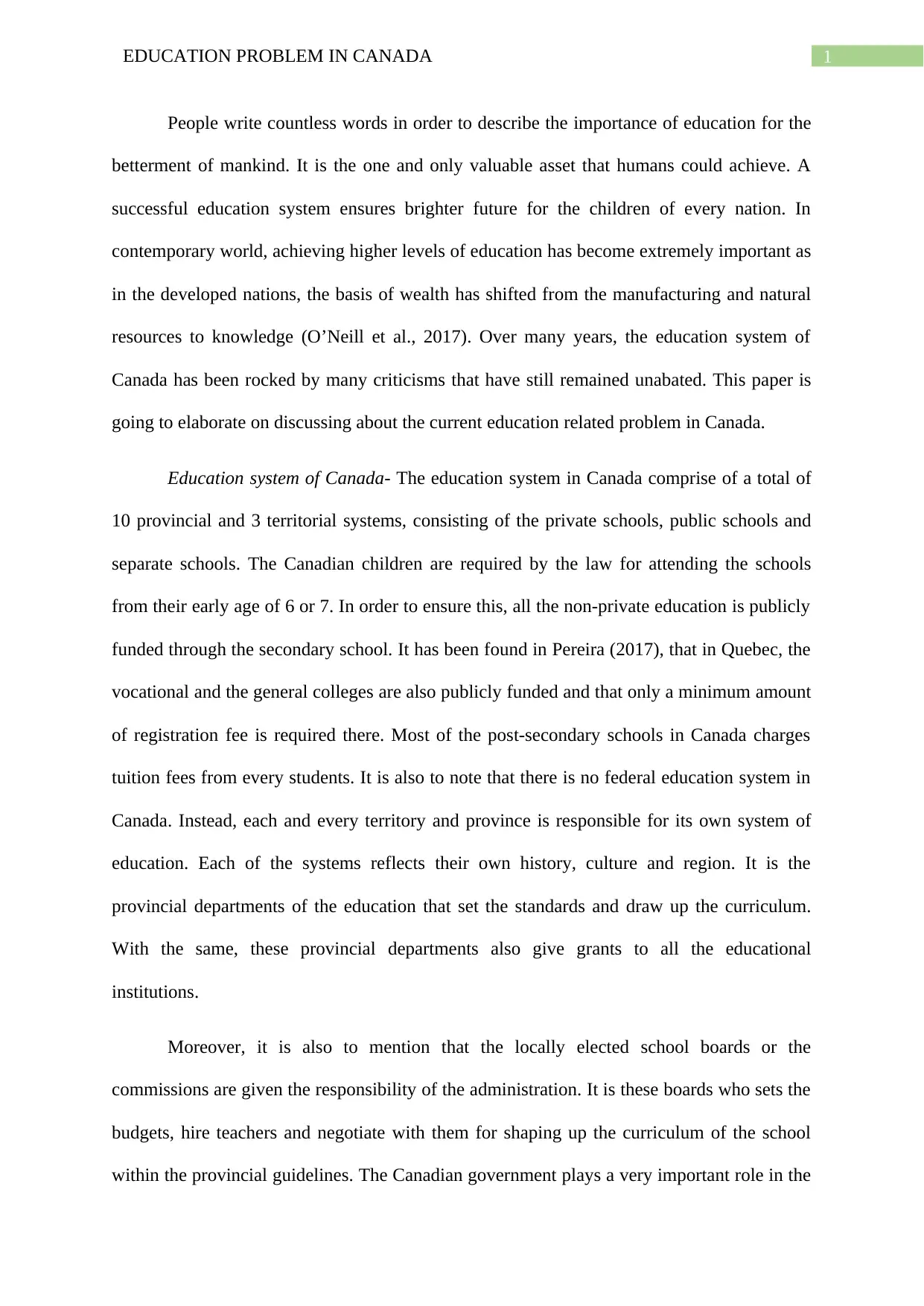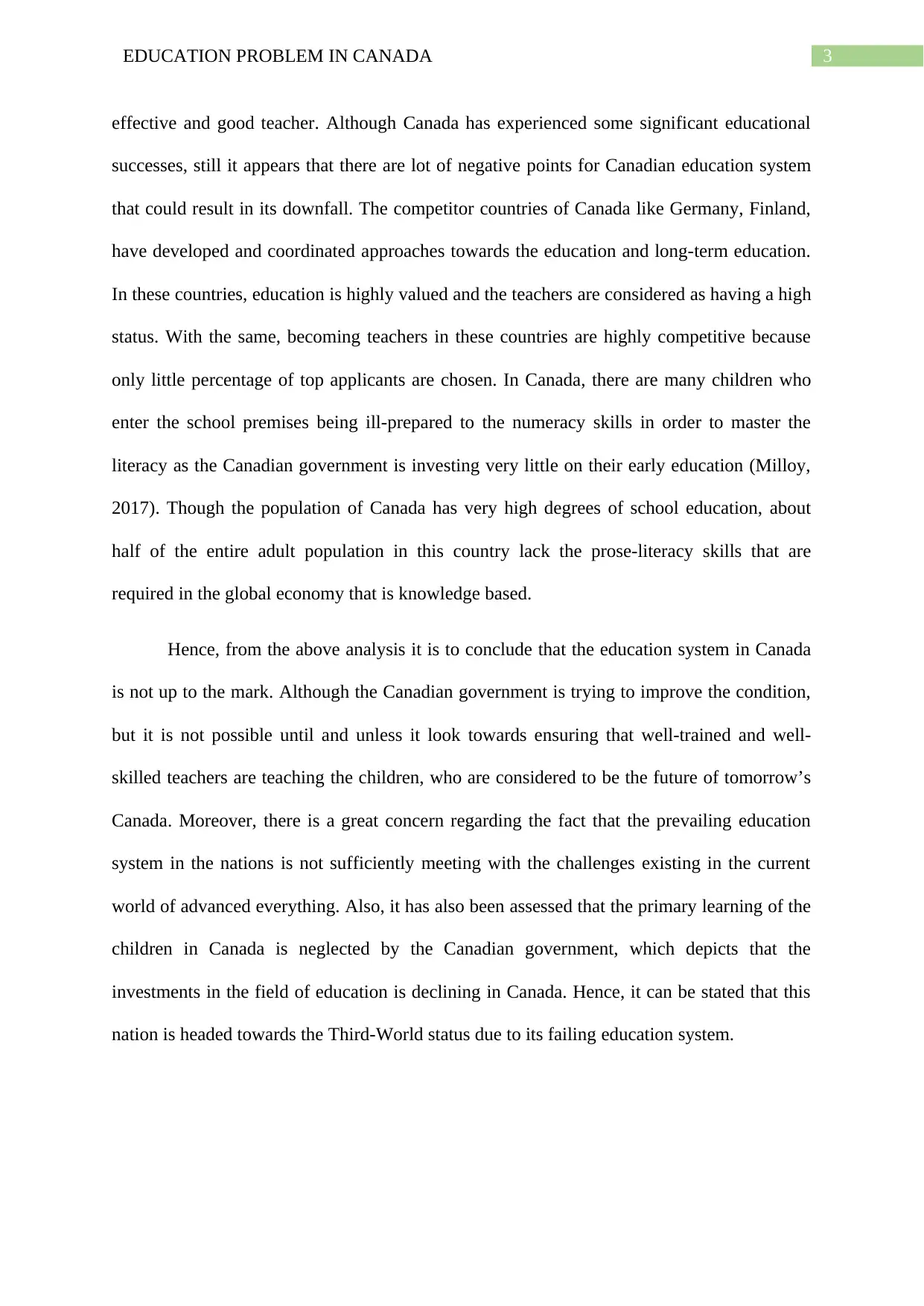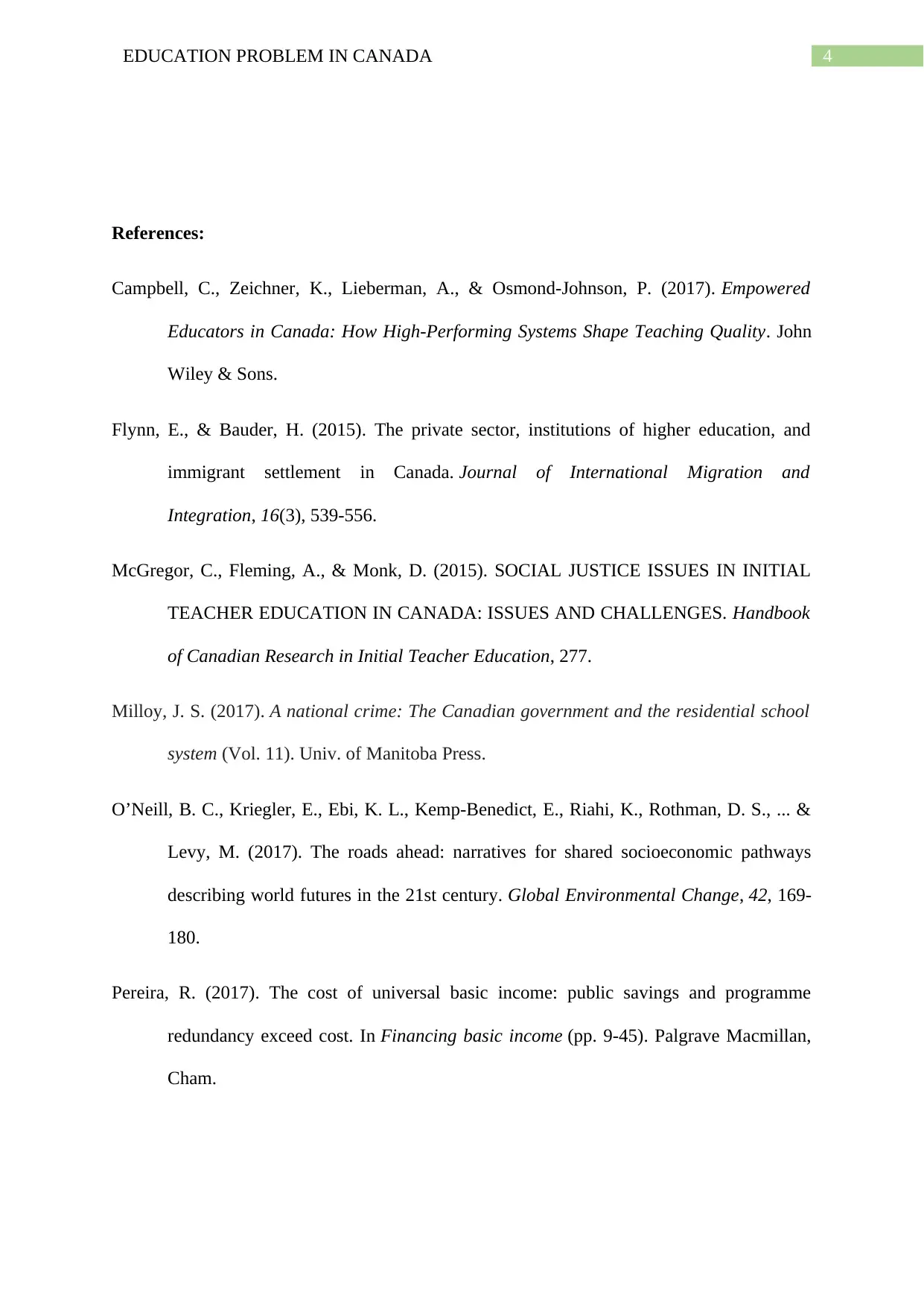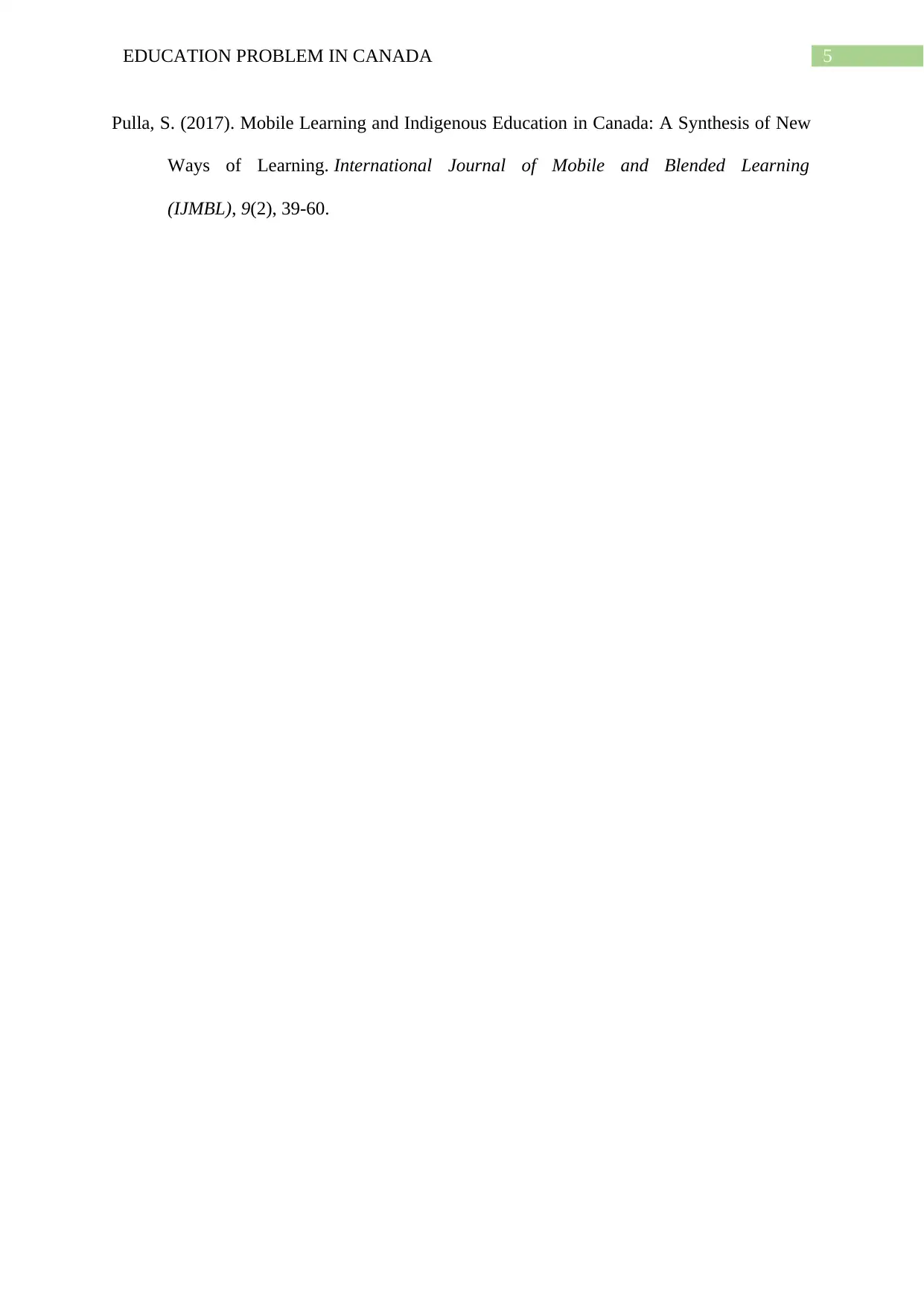Critical Review: Education Problems and Solutions in Canada
VerifiedAdded on 2023/04/24
|6
|1491
|431
Essay
AI Summary
This essay explores the critical issues within Canada's education system, highlighting the transition of wealth from manufacturing to knowledge-based resources and the persistent criticisms of the Canadian education model. It describes Canada's decentralized education system, comprising provincial and territorial systems with public, private, and separate schools, noting the absence of a federal education system. The essay identifies problems such as the focus on formal education for labor force production, high tuition fees at the post-secondary level, under-trained teachers, crowded curriculum, and the overemphasis on grades rather than learning. It also addresses concerns about youth violence, suicide, and depression, alongside the limited accessibility of higher education due to financial constraints and unequal resource distribution. The author suggests that Canada's education system is falling behind competitor countries due to insufficient investment in early education, inadequate literacy skills among adults, and a lack of coordinated approaches to long-term educational development. The essay concludes that improvements are necessary to ensure well-trained teachers and a focus on primary learning to prevent Canada from declining in global educational standards; access this document and more study resources on Desklib.

Running head: EDUCATION PROBLEM IN CANADA
Education Problem in Canada
Name of the Student:
Name of the University:
Author note:
Education Problem in Canada
Name of the Student:
Name of the University:
Author note:
Paraphrase This Document
Need a fresh take? Get an instant paraphrase of this document with our AI Paraphraser

1EDUCATION PROBLEM IN CANADA
People write countless words in order to describe the importance of education for the
betterment of mankind. It is the one and only valuable asset that humans could achieve. A
successful education system ensures brighter future for the children of every nation. In
contemporary world, achieving higher levels of education has become extremely important as
in the developed nations, the basis of wealth has shifted from the manufacturing and natural
resources to knowledge (O’Neill et al., 2017). Over many years, the education system of
Canada has been rocked by many criticisms that have still remained unabated. This paper is
going to elaborate on discussing about the current education related problem in Canada.
Education system of Canada- The education system in Canada comprise of a total of
10 provincial and 3 territorial systems, consisting of the private schools, public schools and
separate schools. The Canadian children are required by the law for attending the schools
from their early age of 6 or 7. In order to ensure this, all the non-private education is publicly
funded through the secondary school. It has been found in Pereira (2017), that in Quebec, the
vocational and the general colleges are also publicly funded and that only a minimum amount
of registration fee is required there. Most of the post-secondary schools in Canada charges
tuition fees from every students. It is also to note that there is no federal education system in
Canada. Instead, each and every territory and province is responsible for its own system of
education. Each of the systems reflects their own history, culture and region. It is the
provincial departments of the education that set the standards and draw up the curriculum.
With the same, these provincial departments also give grants to all the educational
institutions.
Moreover, it is also to mention that the locally elected school boards or the
commissions are given the responsibility of the administration. It is these boards who sets the
budgets, hire teachers and negotiate with them for shaping up the curriculum of the school
within the provincial guidelines. The Canadian government plays a very important role in the
People write countless words in order to describe the importance of education for the
betterment of mankind. It is the one and only valuable asset that humans could achieve. A
successful education system ensures brighter future for the children of every nation. In
contemporary world, achieving higher levels of education has become extremely important as
in the developed nations, the basis of wealth has shifted from the manufacturing and natural
resources to knowledge (O’Neill et al., 2017). Over many years, the education system of
Canada has been rocked by many criticisms that have still remained unabated. This paper is
going to elaborate on discussing about the current education related problem in Canada.
Education system of Canada- The education system in Canada comprise of a total of
10 provincial and 3 territorial systems, consisting of the private schools, public schools and
separate schools. The Canadian children are required by the law for attending the schools
from their early age of 6 or 7. In order to ensure this, all the non-private education is publicly
funded through the secondary school. It has been found in Pereira (2017), that in Quebec, the
vocational and the general colleges are also publicly funded and that only a minimum amount
of registration fee is required there. Most of the post-secondary schools in Canada charges
tuition fees from every students. It is also to note that there is no federal education system in
Canada. Instead, each and every territory and province is responsible for its own system of
education. Each of the systems reflects their own history, culture and region. It is the
provincial departments of the education that set the standards and draw up the curriculum.
With the same, these provincial departments also give grants to all the educational
institutions.
Moreover, it is also to mention that the locally elected school boards or the
commissions are given the responsibility of the administration. It is these boards who sets the
budgets, hire teachers and negotiate with them for shaping up the curriculum of the school
within the provincial guidelines. The Canadian government plays a very important role in the

2EDUCATION PROBLEM IN CANADA
education sector. It is the government that provides all the financial support for the post-
secondary education, teaching of French and English language along with two other official
ones and at the same time, finances the labour market training as well (Flynn & Bauder,
2015). With the same, the Canadian government is also responsible for ensuring that the
aboriginal population, the people in the armed forces as well as the inmates of the federation
correctional institution are getting sufficient education.
Issues in the education system of Canada- To my experience, in Canada, the focus is
on the formal education that is directed at the production of an effective labour force
(McGregor, Fleming & Monk, 2015). With the same, education is not free at the post-
secondary level and all the students, despite of their financial background, caste, gender etc.
need to pay the books and tuition fees. In other countries like China, Singapore and Finland
are highly trained, respected and supported. Moreover, the teachers in the Canadian schools
cannot use any planned teaching strategies as the curriculum is too much crowded.
Furthermore, the Grades system in the Canadian schools have made ‘grades’, the main aim of
education instead of ‘learning’ (Pulla, 2017). Also, there is an increase rate of youth violence,
suicide and depression among the younger students in Canada. I have also noticed that they
are focused on the wrong aspects of our education. The urgency should be on the
improvement of the quality of the teachers but most of the teachers are under-trained and are
under-educated as well. Moreover, although the post-secondary enrolment rate of Canada are
among the highest one in the world, the accessibility of education within the Canada is very
limited. Although, in most of the places, the secondary and the elementary schoolings are
provided to children for free, but the universities and the colleges are not. They are very
costly and money is not distributed equally in every departments (Campbell et al., 2017).
Earning the degree of B.Ed. is very easy and therefore, it attract good range of candidates
who do not even have the skills, passion, knowledge and commitment for becoming an
education sector. It is the government that provides all the financial support for the post-
secondary education, teaching of French and English language along with two other official
ones and at the same time, finances the labour market training as well (Flynn & Bauder,
2015). With the same, the Canadian government is also responsible for ensuring that the
aboriginal population, the people in the armed forces as well as the inmates of the federation
correctional institution are getting sufficient education.
Issues in the education system of Canada- To my experience, in Canada, the focus is
on the formal education that is directed at the production of an effective labour force
(McGregor, Fleming & Monk, 2015). With the same, education is not free at the post-
secondary level and all the students, despite of their financial background, caste, gender etc.
need to pay the books and tuition fees. In other countries like China, Singapore and Finland
are highly trained, respected and supported. Moreover, the teachers in the Canadian schools
cannot use any planned teaching strategies as the curriculum is too much crowded.
Furthermore, the Grades system in the Canadian schools have made ‘grades’, the main aim of
education instead of ‘learning’ (Pulla, 2017). Also, there is an increase rate of youth violence,
suicide and depression among the younger students in Canada. I have also noticed that they
are focused on the wrong aspects of our education. The urgency should be on the
improvement of the quality of the teachers but most of the teachers are under-trained and are
under-educated as well. Moreover, although the post-secondary enrolment rate of Canada are
among the highest one in the world, the accessibility of education within the Canada is very
limited. Although, in most of the places, the secondary and the elementary schoolings are
provided to children for free, but the universities and the colleges are not. They are very
costly and money is not distributed equally in every departments (Campbell et al., 2017).
Earning the degree of B.Ed. is very easy and therefore, it attract good range of candidates
who do not even have the skills, passion, knowledge and commitment for becoming an
⊘ This is a preview!⊘
Do you want full access?
Subscribe today to unlock all pages.

Trusted by 1+ million students worldwide

3EDUCATION PROBLEM IN CANADA
effective and good teacher. Although Canada has experienced some significant educational
successes, still it appears that there are lot of negative points for Canadian education system
that could result in its downfall. The competitor countries of Canada like Germany, Finland,
have developed and coordinated approaches towards the education and long-term education.
In these countries, education is highly valued and the teachers are considered as having a high
status. With the same, becoming teachers in these countries are highly competitive because
only little percentage of top applicants are chosen. In Canada, there are many children who
enter the school premises being ill-prepared to the numeracy skills in order to master the
literacy as the Canadian government is investing very little on their early education (Milloy,
2017). Though the population of Canada has very high degrees of school education, about
half of the entire adult population in this country lack the prose-literacy skills that are
required in the global economy that is knowledge based.
Hence, from the above analysis it is to conclude that the education system in Canada
is not up to the mark. Although the Canadian government is trying to improve the condition,
but it is not possible until and unless it look towards ensuring that well-trained and well-
skilled teachers are teaching the children, who are considered to be the future of tomorrow’s
Canada. Moreover, there is a great concern regarding the fact that the prevailing education
system in the nations is not sufficiently meeting with the challenges existing in the current
world of advanced everything. Also, it has also been assessed that the primary learning of the
children in Canada is neglected by the Canadian government, which depicts that the
investments in the field of education is declining in Canada. Hence, it can be stated that this
nation is headed towards the Third-World status due to its failing education system.
effective and good teacher. Although Canada has experienced some significant educational
successes, still it appears that there are lot of negative points for Canadian education system
that could result in its downfall. The competitor countries of Canada like Germany, Finland,
have developed and coordinated approaches towards the education and long-term education.
In these countries, education is highly valued and the teachers are considered as having a high
status. With the same, becoming teachers in these countries are highly competitive because
only little percentage of top applicants are chosen. In Canada, there are many children who
enter the school premises being ill-prepared to the numeracy skills in order to master the
literacy as the Canadian government is investing very little on their early education (Milloy,
2017). Though the population of Canada has very high degrees of school education, about
half of the entire adult population in this country lack the prose-literacy skills that are
required in the global economy that is knowledge based.
Hence, from the above analysis it is to conclude that the education system in Canada
is not up to the mark. Although the Canadian government is trying to improve the condition,
but it is not possible until and unless it look towards ensuring that well-trained and well-
skilled teachers are teaching the children, who are considered to be the future of tomorrow’s
Canada. Moreover, there is a great concern regarding the fact that the prevailing education
system in the nations is not sufficiently meeting with the challenges existing in the current
world of advanced everything. Also, it has also been assessed that the primary learning of the
children in Canada is neglected by the Canadian government, which depicts that the
investments in the field of education is declining in Canada. Hence, it can be stated that this
nation is headed towards the Third-World status due to its failing education system.
Paraphrase This Document
Need a fresh take? Get an instant paraphrase of this document with our AI Paraphraser

4EDUCATION PROBLEM IN CANADA
References:
Campbell, C., Zeichner, K., Lieberman, A., & Osmond-Johnson, P. (2017). Empowered
Educators in Canada: How High-Performing Systems Shape Teaching Quality. John
Wiley & Sons.
Flynn, E., & Bauder, H. (2015). The private sector, institutions of higher education, and
immigrant settlement in Canada. Journal of International Migration and
Integration, 16(3), 539-556.
McGregor, C., Fleming, A., & Monk, D. (2015). SOCIAL JUSTICE ISSUES IN INITIAL
TEACHER EDUCATION IN CANADA: ISSUES AND CHALLENGES. Handbook
of Canadian Research in Initial Teacher Education, 277.
Milloy, J. S. (2017). A national crime: The Canadian government and the residential school
system (Vol. 11). Univ. of Manitoba Press.
O’Neill, B. C., Kriegler, E., Ebi, K. L., Kemp-Benedict, E., Riahi, K., Rothman, D. S., ... &
Levy, M. (2017). The roads ahead: narratives for shared socioeconomic pathways
describing world futures in the 21st century. Global Environmental Change, 42, 169-
180.
Pereira, R. (2017). The cost of universal basic income: public savings and programme
redundancy exceed cost. In Financing basic income (pp. 9-45). Palgrave Macmillan,
Cham.
References:
Campbell, C., Zeichner, K., Lieberman, A., & Osmond-Johnson, P. (2017). Empowered
Educators in Canada: How High-Performing Systems Shape Teaching Quality. John
Wiley & Sons.
Flynn, E., & Bauder, H. (2015). The private sector, institutions of higher education, and
immigrant settlement in Canada. Journal of International Migration and
Integration, 16(3), 539-556.
McGregor, C., Fleming, A., & Monk, D. (2015). SOCIAL JUSTICE ISSUES IN INITIAL
TEACHER EDUCATION IN CANADA: ISSUES AND CHALLENGES. Handbook
of Canadian Research in Initial Teacher Education, 277.
Milloy, J. S. (2017). A national crime: The Canadian government and the residential school
system (Vol. 11). Univ. of Manitoba Press.
O’Neill, B. C., Kriegler, E., Ebi, K. L., Kemp-Benedict, E., Riahi, K., Rothman, D. S., ... &
Levy, M. (2017). The roads ahead: narratives for shared socioeconomic pathways
describing world futures in the 21st century. Global Environmental Change, 42, 169-
180.
Pereira, R. (2017). The cost of universal basic income: public savings and programme
redundancy exceed cost. In Financing basic income (pp. 9-45). Palgrave Macmillan,
Cham.

5EDUCATION PROBLEM IN CANADA
Pulla, S. (2017). Mobile Learning and Indigenous Education in Canada: A Synthesis of New
Ways of Learning. International Journal of Mobile and Blended Learning
(IJMBL), 9(2), 39-60.
Pulla, S. (2017). Mobile Learning and Indigenous Education in Canada: A Synthesis of New
Ways of Learning. International Journal of Mobile and Blended Learning
(IJMBL), 9(2), 39-60.
⊘ This is a preview!⊘
Do you want full access?
Subscribe today to unlock all pages.

Trusted by 1+ million students worldwide
1 out of 6
Related Documents
Your All-in-One AI-Powered Toolkit for Academic Success.
+13062052269
info@desklib.com
Available 24*7 on WhatsApp / Email
![[object Object]](/_next/static/media/star-bottom.7253800d.svg)
Unlock your academic potential
Copyright © 2020–2025 A2Z Services. All Rights Reserved. Developed and managed by ZUCOL.





